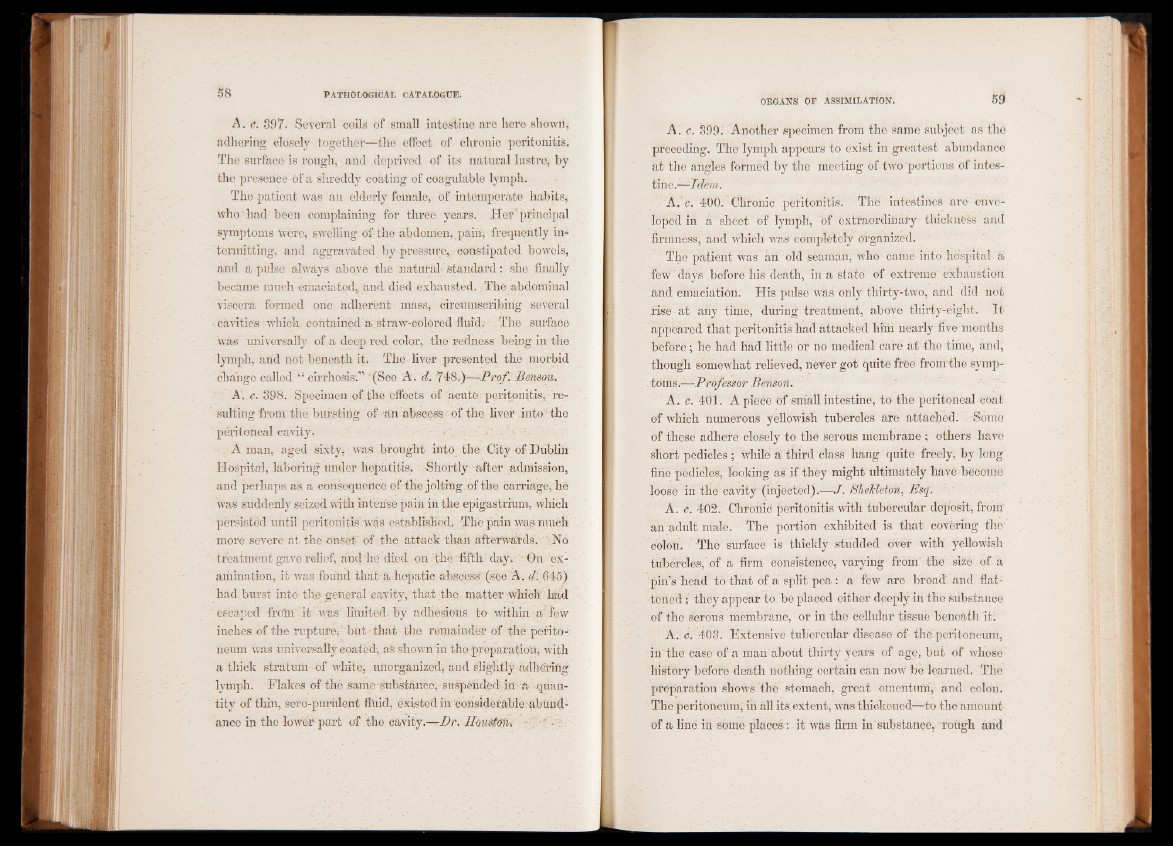
A. c. 397. Several coils of small intestine are here shown,
adhering closely together—the effect of chronic peritonitis.
The surface is rough, and deprived of its natural lustre, by
the presence of a shreddy coating of coagulable lymph.
The .patient was an elderly female, of intemperate habits,
who had been complaining, for three years. Her principal
symptoms Were, swelling of the abdomen, pain, frequently intermitting,
and aggravated by pressure,., constipated bowels,
and a pulse always above the natural- standard: she finally
became much emaciated, and died exhausted. The abdominal
viscera formed one adherent mass, circumscribing several
cavities:. which, contained a. straw-colored fluid. . The surface
was .universally of a deep red color, the redness being in the
lymph, and not beneath it. The liver presented the morbid
change called “ cirrhosis.” (See A. d. 748.)—-/V«/’. Henson.
A. c. 398. Specimen of the effects of acute peritonitis,'resulting
from the. bursting of- an abscess of the liver into"'the
' peritoneal cavity.
■ A man, aged sixty, - was brought into the City of Dublin
Hospital, laboring under- hepatitis. Shortly after admission,
and perhaps as a consequence of the jolting, of the carriage, he
was suddenly seized with intense pain in the' epigastrium, which
persisted until peritonitis was established. The pain was much
more severe at t he onset of the attack than afterwards. ‘-.No
treatment gave relief, and he died on 'the fifth day. On examination,
it was found that a hepatic abscess (see A . dl 645)
had burst into the general cavity, that the matter which' had
escaped -from it was limited, by adhesions to within a'few
inches of the ruptures but that the remainder of the peri to-'
neum was universally coated-, a'S shown in the preparation; with
a thick stratum of white; unorganized, and sfigdltly-adhering
lymph. Flakes of the same umbstance, • suspended:; in - a quantity
of thin, sere-purulent fluid, existed in considerable abundance
in the lower part of the cavity .—Dr. Houston
A. c. 399. Another specimen from the same subject as the
preceding. The lymph appears to exist in greatest abundance
at the angles formed by the meeting of two portions of intestine.—
Idem.
A.'c. 400. Chronic peritonitis. The intestines are enveloped
in a ' sheet of lymph, of extraordinary thickness and
firmness, and which was completely organized.
The patient was an old seaman, who came into hospital a
few days before his death, in a state of extreme exhaustion
and emaciation. His pulse was only thirty-two, and did not
rise at any time, during treatment, above thirty-eight. If
appeared that peritonitis had attacked him nearly five months
before; he had had little or no medical care at the time, and;
though somewhat relieved, nefer got quite free fronrthe symptoms.—
Professor Benson.
A. c. 401. A piece of small intestine, to the peritoneal cOat
of which numerous yellowish tubercles are attached. Some
of these adhere closely to the serous membrane ; others have
short pedicles ; while a third class hang quite freely, by long
fine pedicles, looking as if they might ultimately have become
loose in the'cavity (injected).—J. SheMeion, Esq.
A. c. 402. Chronic peritonitis with tubercular deposit, from
an adult male. The portion exhibited is that covering the-
colon. The surface is thickly studded over with' yellowish
tubercles, of a firm consistence, varying from the size" of a
pin’s head to that of a split pea : a few are bread , and flat-
- toned; they appear to be placed either deeply in the substance
of the serous membrane, or in the cellular tissue beneath if
A. c. 403. Extensive tubercular disease of the. peritoneum,
in the case of a man about thirty years of age, but of whose
history before death nothing certain can now be learned. The
preparation shows the stomach, great omentum, and colon.
The peritoneum, irt all its. extent, was thickened—to the amount
of a lino in some places: it was firm in substance, rough and